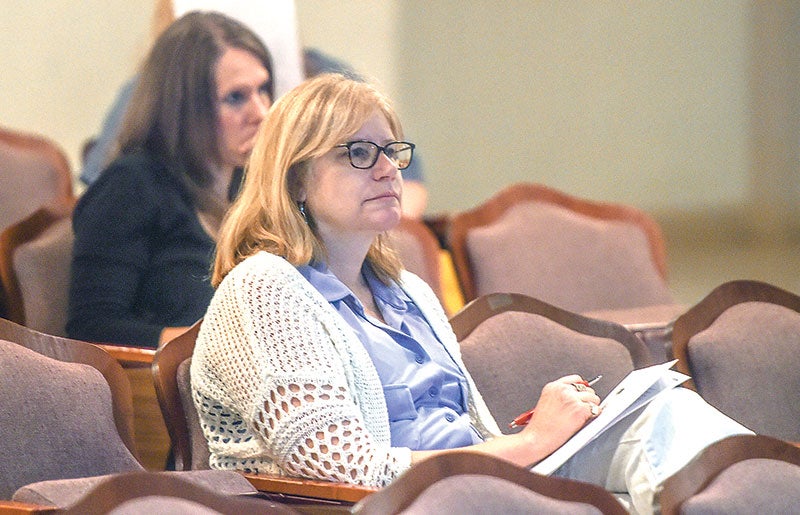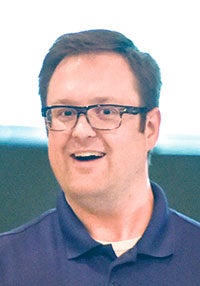Shortages not limited to full-time educators
Published 8:18 am Thursday, August 9, 2018

- Attendees listen to Travis Chapman of Teachers on Call during a seminar for substitute teachers Wednesday morning. Eric Johnson/photodesk@austindailyherald.com
The need for full-time teachers wasn’t the only thing that school districts were challenged with. They also need the people who can sub in for them.
Inside Christgau Hall at Austin High School on Wednesday morning, four soon-to-be substitute teachers and paraprofessionals sat in on a training session, hosted by Teachers On Call (TOC), a Bloomington-based company that helps school districts like Austin Public Schools fill in the need of substitutes.
Leading those sessions included Travis Chapman, TOC substitute training specialist. Although shortages of substitute teachers and paraprofessionals haven’t been a new subject in education, it’s still affecting school districts across the country, including Austin.
On average teachers are out of the classroom for 11 days per year, according to a 2014 National Council on Teacher Quality study. About 48 percent of schools face a “severe or somewhat severe” shortage of substitute teachers in 2013.
APS Human Resources Specialist Sue Stark said that in previous years, the district would encounter some challenges in finding substitutes for their full-time teachers and paraprofessionals, especially during times when a teacher becomes ill, needs to take a professional development day, or a scheduled personal day off.
“There are some days that our needs are large, and it goes along with the cold and flu season, and additional staff are then gone,” Stark said. “The greater number of staff gone, then the greater number of subs are needed. Sometimes we weren’t able to meet that, and that’s when we have staff within the building step up and fill in.”
For two years, APS has been using TOC to help with substitute staffing shortages. The district has 134 active substitutes working through the company, and 42 of these substitutes work for multiple school districts, including some coming from as far as Rochester, Stewartville and Spring Valley, according to data provided by APS.
“We were doing fine when we staffed substitutes ourselves,” Stark said. “We’ve been pretty lucky and we’re filling a large amount of the need through Teachers On Call that really opened up the search area.”

Travis Chapman, TOC substitute training specialist
There may be some causes to the shortages, including: low wages, scheduling conflicts and also lack of training. Chapman shared that the most common thing he heard while training substitutes was that many in the public were uncertain of what was expected of them in the classroom, and find a lack of training resources available to them.
“We want those resources to be more accessible, and help people into this process,” he said.
Other school districts weren’t so lucky at times. Chapman recalled there were districts where there weren’t enough substitutes, and students would be split into other classrooms to receive their education for the day. Sometimes, teachers would return and find that they had no substitutes filling in for them. Ultimately, the shortages affect the most important part of the classroom: the students.
“(This shortage) affects the entire school,” Chapman said. “A lot of stress is placed on the teachers and paraprofessionals, but also on the students.”
If interested … apply
There are differences in requirements someone needs to meet before becoming a substitute teacher or paraprofessional:
Paraprofessional: Chapman explained that a paraprofessional—interchangeable with teacher’s aide—can be anyone who has at least received their GED or high school diploma.Paraprofessionals also must meet additional requirements with one of three options that are available in the state per the Minnesota Department of Education standards:
Option A means completing at least two years of study at an institution of higher education
Option B the individual obtained an associate’s degree or higher
Option C demonstrates the knowledge of and the ability to assist in instructing reading, writing and mathematics, or as appropriate readiness for each of the subject area by passing the ParaPro test with a minimum score of 460.
Substitute Teacher: The Minnesota Department of Education (MDE) issues two substitute teacher licenses: the two-year, “short call” substitute teacher license, and the five-year, short call substitute teacher license. To apply for a license as a substitute in Minnesota, an interested individual would need to create an account and apply online with the MDE, and then choose one of the categories of licenses based on background and experience, according to TOC.
Two-year short call substitute license can be obtained by anyone who has a bachelor’s degree. It’s valid for short term substitute assignments only (less than 15 days) in any grade and subject area.
Five-year short call substitute license can be obtained by those who finished a teacher licensure program, but don’t want to apply for a full-time licensure. It’s valid for short-term substitute assignments (less than 15 days in any grade or subject.
Chapman stated that making the resources available for those interested in becoming a substitute paraprofessional or teacher would benefit school districts, as well as addressing the challenges of shortages that are widespread across the country.
He also shared that many people have become substitutes come from different vocational backgrounds, and some even found a passion for education and became teachers through substituting.
“I’ve talked to an engineer who spent 30 to 40 years in the field, and then said they wanted to give back and do something in education,” Chapman said. “I’ve met a student who graduated with her education degree, but wasn’t sure about what she wanted to do with it, and so became a sub to test things out.”
These substitute staffing opportunities were also a way for some to get a taste of what it’s like to be in the educational career field, or using it as a stepping stone. Some may find substitute staffing as a more flexible option to work around their own schedules. One of the attendees of the training session was Kristina Durham of Austin. She worked in APS as a paraprofessional since 2005, and although hasn’t finished her degree in elementary education, Durham found fulfillment in being able to interact with students.
“It’s kind of the next best thing,” she said. “I’m still able to work with students in a way that’s cohesive with family life.”


